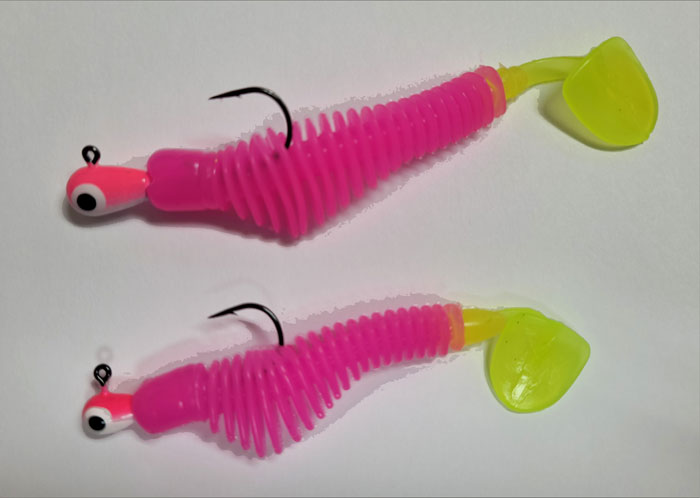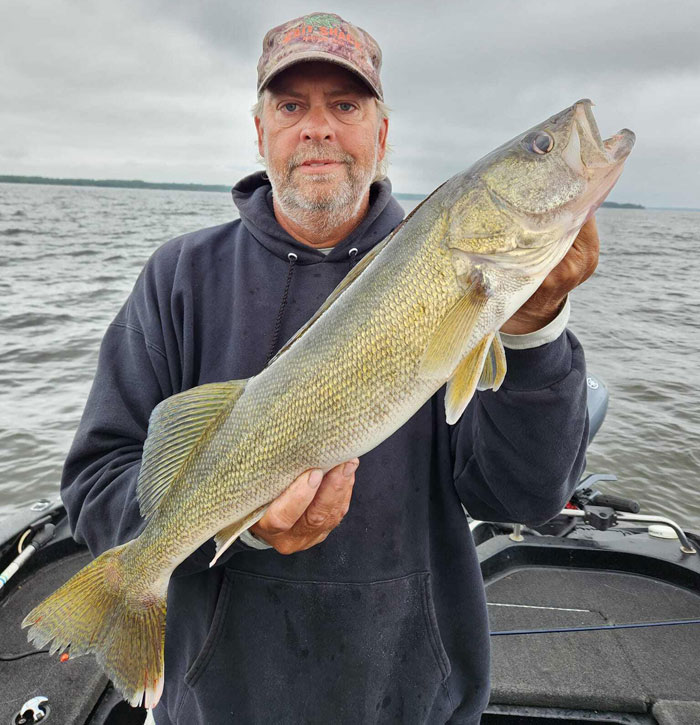Fishing Heavy Jigs, Light Jigs and Jigs In-Between on the Edge and Beyond!
Posted by Walt Matan, Chief Product Designer on Jun 11th 2024
Posted by Walt Matan, Chief Product Designer on Jun 11th 2024
I’ve lost hundreds of jigs over the years. I would tie on a 3/8th ounce jig, add a minnow, drop it down and get snagged. I’d try to free it loose, bust the line, tie on another 3/8th ounce jig, snag it up and start all over again.
The problem was that sometimes I wouldn’t snag right away, I would actually catch a walleye, so I knew the 3/8th ounce jig just HAD to be the right weight so there was no reason to try anything different.
In a river, fish can be caught in a lot of different areas. It’s all related to river depth and current speed. In low water a lot of walleye, sauger, white bass, catfish...well basically any gamefish can be caught in the main channel and deep holes. When the river is higher or you have good current, they like to head to the current break and eddy areas...right on the edge.

A lot of anglers have trouble working a current seam. Boat control can be a mess. I start by spot-locking my boat in the slack water near the current break. Then I’ll make an upstream cast into the current and let my jig tumble downstream.
The key is to use a jig that is just heavy enough to touch bottom once in a while without snagging up. When it gets to the end of the line, I’ll reel in slowly, with twitches intermittently.
What I tip my jig with affects the jig weight I use. A 1/8 ounce jig tipped with a minnow might work just right, but if you use plastic instead of the minnow you’ll need to up-size to a 3/16th ounce or even a 1/4. And depending on the size of the plastic you might have to change again.


That’s why I like to have three rods rigged up with different weight jig and plastic combos. An AuthentX Ringworm is a top choice, it is thin and might only need a little increase in jig weight.
A Pulse-R or Moxi has a lot more “beef” and requires a slightly heavier jig to give the same tumbling effect and then there is live bait like a minnow or crawler which you can use with a lighter weight jig.

Back in the days of snagging up that 3/8th ounce jig, I had a great sensitive rod, I still have it today and I’ve caught a ton of fish with it, but back then I used 10 lb mono line, which gave a “mushy” feel to the bottom, which was why I was always snagging.
Currently, I like to use a 10 pound bright colored braid, Power Pro is a good choice, low stretch, thin, hi visibility. I’ll add 10 lb. Fluoro leader about four foot long and attach my jig.
The St. Croix Eyecon Snap Jig rod is my go-to along with an Okuma Ceymar 30 reel. This whole set-up runs a little over $200 and is well worth the money. With this combo, I can feel when the jig ticks bottom which keeps me from snagging so often.
You need to be able to identify a jigs weight quickly and have different colored jigs in multiple weights. So you get you a Plano box, mark off the compartments with the different weights with a Sharpie and keep them all separated.
Inevitably, you will drop that jig box, spilling all your jigs everywhere, and it gets all mixed up. You straighten it all back up the best you can, but a year later it’s a mess, so finally you just pile them all together in a big lump. Lump is bad.
I’m a big fan of Custom Jigs & Spins H20 Jigs.The H20 jig has nine different weights and 21 different colors to choose from. It has an ultra-sharp premium hook, a wire keeper molded into the head that holds plastic and live bait close to the head, and the weight is stamped on the bottom of the jig for easy weight identification.
So not only can I pick the right jig when fishing, I can also put them all back in the Plano box correctly after I dump it in the bottom of the boat!
A dropshot rig consists of a weight on bottom and a hook up above, rigged with live bait or plastic. Drop shot rigs work on all species, you just have to adjust your hook size to what you are looking to catch. I’ll use an H20 jig on bottom and a dropshot hook up above.
VMC hooks makes a Spinshot hook which is a hook with swivels attached above and below. You tie your main line directly to the top swivel and make a 18” leader tied to the bottom swivel and then to your H20 jig. I like to use their #1 size hook when walleye fishing.

I’ll put an AuthentX Paddletail or Ribb-Finn on the Spinshot hook and a Ringworm or Moxi on the H20 jig. This rig can be pitched in the current seam for some fast action...oftentimes I’ll get doubles on white bass, sauger and walleye!
So next time you go walleye, white bass or smallmouth fishing on the river, give some of these jigging techniques a try and you may be rewarded with a trophy as well as some fine eaters!

To find out more about BFishN Tackle’s line of H20 jigs, B3 Blade Baits, AuthentX Ringworms, Moxi’s, Pulse-R’s, Ribb-Finn’s and Paddletails go to www.bfishntackle.com or you can link to it via www.customjigs.com. Also, be sure to follow/like Custom Jigs & Spins, B-fish-N Tackle and Walt Matan on Facebook for some up to the minute info or call 1-800-831-5535 for a FREE 2024 Tips and Tricks Catalog.